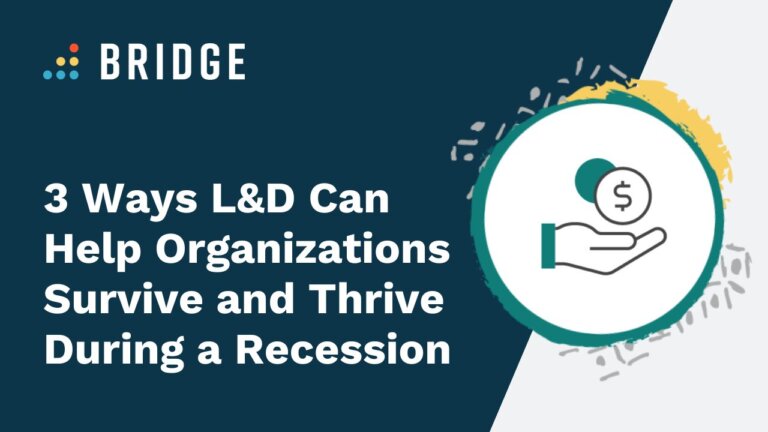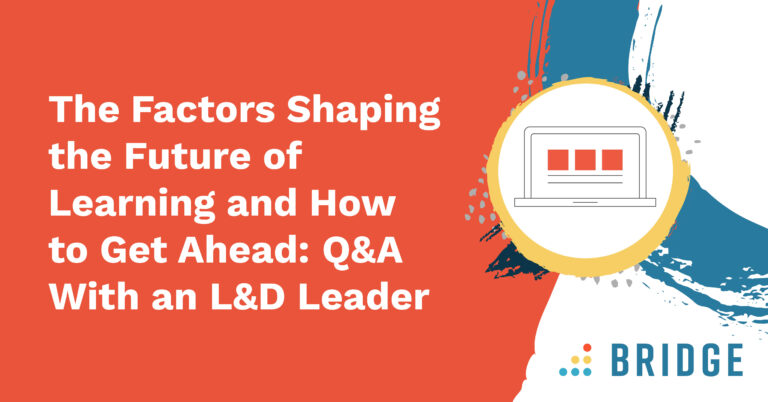For organizations, the only certainty is uncertainty. Faced with tighter margins, many leaders need a fresh approach to engage, retain, and develop employees with the skills for the future of work.
As data from a McKinsey survey shows, organizations that display resilient behaviors such as innovation, knowledge sharing, and performance reviews are over 2.5 times more likely to withstand major disruption than those that don’t.
When events conspire to throw plans into doubt and cast a question mark against decisions, businesses need a strategy in place to plan, prepare, and make decisions with confidence.
3 Tactics to Redefine the Employee Experience to Build Engagement and Trust
Investing in existing talent makes good sense. Employee engagement matters, and for businesses that don’t focus on existing talent, the costs can be enormous. Gallup’s 2022 State of the Workplace Report shows that low engagement costs the global economy US$7.8 trillion, which equates to 11% of GDP globally.
Though the temptation to cut costs could leave some businesses scaling back on talent, look at an investment in existing talent as a chance to boost culture and inspire long-term growth and productivity.
Here are three tactics to recession-proof your organization with a focus on learning and skills development, followed by four ways to transform your talent with a skills-based approach, and three tips for HR tech investment.
HOW TO ENGAGE EMPLOYEES | ‘4 Ways to Create a Culture of Conversation for Your Organization’
1) Make Employee Wellbeing a Priority
Employee wellbeing isn’t a separate issue, but a defining factor in overall business success. When organizations create resilience by driving home the human aspects of culture and wellbeing, they can build greater resilience against disruption.
Indeed’s Wellbeing at Work report shows the positive impact employee wellbeing has on performance. When organizations create a people-centric work environment and put trust, appreciation, and belonging into workplace practices, it results in employees who are:
- 3x more likely to be focused on their daily tasks
- 2x less likely to make mistakes at work
- 1.5x less likely to consider new opportunities elsewhere
A strong health and wellbeing policy should promote a healthy work-life balance, offer training to protect against burnout and stress, and provide resources and services to support people. Measuring satisfaction and wellbeing through check-ins, one-on-ones, and engagement surveys is a worthwhile way to make sure employees feel valued and listened to, and show that they’re supported.
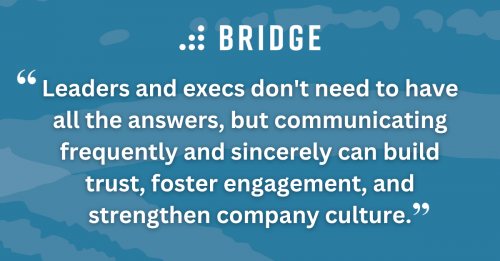
WANT MORE WAYS TO BOLSTER WORKPLACE WELLBEING? READ THIS! | ‘How to Boost Employee Wellbeing in the Workplace’
2) Retain Existing Talent With a Focus on Learning and Development
Growth is a priority at all levels, and for your people, it means the desire to advance in their careers and learn new things.
Findings in LinkedIn’s 2023 Workplace Learning Report show that three out of the top five reasons employees leave an organization relate to a lack of learning and development opportunities. In response, providing more learning opportunities is the number-one way employers are working to improve retention.
Your people need to know that L&D is a priority, is deeply embedded into company culture, and reinforced with relevant opportunities. Making learning and development part of the wider employee experience requires a shared vision. For leaders, it’s about showing and celebrating the value of development and prioritizing training initiatives to create enthusiasm.
Managers should work with people to uncover their unique career drivers during one-on-ones, map their ambitions to personalized training plans, and create SMARTER performance goals to measure the impact of training.
ESTABLISH PURPOSEFUL GOALS | ‘What Are SMARTER Goals and How Do They Help Measure Employee Productivity?’
3) Put People at the Center of Change Initiatives
While leaders and execs are busy refining strategies and planning ahead, they should never forget about what’s happening in the present and communicate with their people.
In times of significant change, high-performing organizations that put people at the heart of decisions are 2.6x more likely to increase profitability and create long-lasting success, according to a report compiled by EY Group and The University of Oxford.
In organizations that successfully manage change:
- 48% of employees say leaders clearly articulate why change is needed
- 49% agree that leaders use the right technology to execute transformation
- 44% say that their organization’s culture encourages innovation and new ways of thinking and working
More than ever, engaging employees in honest conversation, listening, and taking time to communicate the context behind broader strategies can influence success. Leaders and execs don’t need to have all the answers, but communicating frequently and sincerely can build trust, foster engagement, and strengthen company culture.
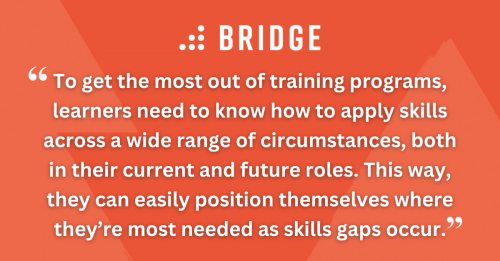
MORE WAYS TO CREATE CONNECTION WITH EMPLOYEES | ‘3 Employee Engagement Ideas for Remote Workers’
4 Ways to Adopt a Skills-Based Approach to Training and Employee Development
In a global Fortune/Deloitte survey of CEOs, over three-quarters listed inflation and a shortage of skills as the biggest issues expected to influence or disrupt strategies in 2023 and beyond. In response, many businesses are upping their efforts on talent and skills development.
Shifting practices to a more flexible and adaptive skills-based approach enables organizations to unlock greater value from their talent. Your organization can become more competitive when you take time to understand the skills and capabilities most needed today and in the future, and develop and place talent in the right areas of your business.
READ MORE ABOUT SKILLS | ‘How Talent Mobility Empowers Employee Development’
1) Upskill, Reskill, and Develop Talent Internally
According to Deloitte research, organizations that adopt a skills-based approach to developing and placing talent are 63% more likely to achieve goals than those that don’t. They’re also 57% more likely to anticipate change and respond effectively and efficiently.
Double down training efforts on existing talent to build the skills and capabilities your organization needs to survive and grow. Start by defining the most in-demand hard and transferable skills and roles. Then, define the training required to prepare a pipeline of talent who can step into roles and adapt across a number of boundaries.
It’s not just the employees with the most experience or those in the most senior roles who can add value, so don’t limit training opportunities to an area or level of the business. Look for employees whose career motivations indicate they want to develop a skillset, find people with skills, and gather examples of feedback from peers and managers that show strong potential.
RELATED READING | ‘Next Steps With Bridge Journeys: 3 New Features That Take Your Learners Further’
2) Break Down Silos to Create Development Opportunities
Use skills to connect learners based on matching strengths, interests, and learning styles. By bringing talent together, you can unlock previously unforeseen opportunities for employees to feed into each others’ development, encourage them to play an active role in training peers, and inject a healthy dose of motivation to keep them on track.
Creating communities based on the skills your employees possess and the ones they want to develop gives learners greater freedom over what, when, and how they learn. Not only does this fuel long-term enthusiasm and encourage self-directed learning, but it also gives people a chance to step into the role of coaches and mentors and develop leadership skills.
By enabling opportunities for real-world skills to practice alongside learning, employees can apply knowledge and behaviors to a specific context and benefit from the expertise of managers and peers with focused feedback in the moment.
When you use skills feedback and one-on-ones to complement other training activities, it’s possible to map learner progress over time to assess how they’re tracking toward goals and using skills on the job.
ENABLE LEARNING IN THE FLOW OF WORK | ‘Beating Burnout: Why Microlearning Is a Must for Time-Poor Teams’
3) Conduct Regular Skills Assessments
To fully leverage employees’ skills and identify critical gaps that require additional resources, you need a consistent language and system. This way, you can define the skills and jobs that exist, track who currently possesses skills and behaviors, and what measurable impact they create.
Establishing a baseline for skills and capabilities means identifying what skills, behaviors, and competencies currently exist, how they’re being used, and in what areas. It’s also a chance to preempt any gaps and find under-utilized areas where employees could put their talents to great use.
By centralizing skills, you pave the way for more effective and meaningful learning and development opportunities. When employees aren’t restricted to a single career path or development program, it’s easier to think about the skills they want to develop and where to apply them.
FUEL ORGANIZATIONAL GROWTH WITH LEARNING AND PERFORMANCE | ‘How Learning and Performance Can Connect, Align, and Grow Your Organization’
4) Curate Existing Training Resources
To get the most out of training programs, learners need to know how to apply skills across a wide range of circumstances, both in their current and future roles. This way, they can easily position themselves where they’re most needed as skills gaps occur.
Think about each step of the learning journey and how activities guide learners in an organic way, giving meaning to the purpose behind activities. Formal learning and training opportunities should be broken down into digestible microlearning chunks and engaging formats to encourage learning in the flow of work. Where possible, reinforce training courses with real-world opportunities such as assignments and coaching opportunities.
With the right learning platform, you can unlock greater insights into how people learn and develop skills and use this to tailor recommendations. Beyond this, drive skills development through informal and in-the-moment experiences such as cohort-based activities and social learning.
CONTENT CURATION MUST-HAVES | ‘6 Content Curation Best Practices to Maximize the Impact of Your L&D Strategy’
3 Tips to Enhance Current and Future L&D Value by Investing in HR Technology
Planning today and making smart investments can stand your organization in good stead tomorrow. A strategic tech purchase could add significant value if used in the right areas. According to responses from 60% of C-suite execs in a PwC report, digital transformation is their most critical growth driver in a time of disruption and uncertainty.
Try to forecast for the long term when making a case for buying a learning platform, think about the skills and training your people need today and into the future, and tie it to tangible metrics.
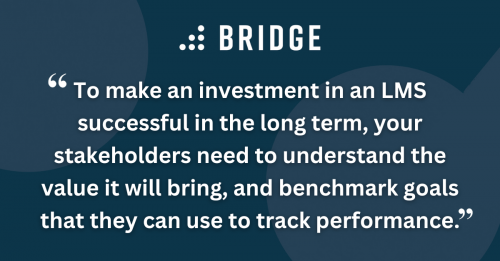
HOW TO SHOW THE ROI OF AN LMS | ‘Making the Case for Your Learning Platform in a Time of Economic Uncertainty’
1) Execute a Tech Rollout With Intention
A tech purchase must always be underpinned by a shared purpose and a strategy. To make an investment in an LMS successful in the long term, your stakeholders need to understand the value it will bring, and benchmark goals that they can use to track performance.
If your organization has a process in place to manage change and a set of well-defined goals in which investments are aligned and agreed upon, it can boost market value by up to 5%, according to Deloitte data. On the other hand, a lack of digital change strategy can potentially drive away up to 9% of a company’s overall value. To ensure a successful purchase, implementation, and continuous user adoption, it’s essential to have both a strong business case to justify costs and clear goals that enable transparency.
MAXIMIZE THE VALUE OF L&D PROGRAMS | ‘How to Create an L&D Budget You Can Defend to Your CFO’
2) Look for an HR Platform That Connects Data
As tech becomes more important for connecting with employees, the right platforms and tools matter. Worryingly, the biggest concern for 40% of HR leaders is a lack of data and analytics, according to a survey conducted by PwC. The best way to overcome the issue for 96% is to find systems designed to gather and connect data.
Think about the tools, technologies, and systems already in place within your organization, their intended purpose, and what data they collect. If your organization currently uses different platforms and data exists in separate systems, each lacking visibility, there’s a potential for much greater insight.
With a system to integrate data, allow stakeholders to align on objectives, and collaborate, businesses are better able to understand and respond to employee needs.
Connecting your data and streamlining your platforms can cut costs and unlock new information and previously hidden correlations that can drive employee decision-making. Investing in a learning platform that integrates with your ecosystem can make previously unseen connections around skills, employee engagement, and goal alignment throughout the company.
3) Tie L&D Technology to ROI to Unlock Value
To show the return on investment from technology and prove ongoing value, tie learning and development initiatives back to the areas that matter most to your organization. CIPD data shows that HR and leadership priorities overlap in several key areas and business leaders expect the significance of non-financial metrics to increase.
Here are some of the most important non-financial measures of success that indicate organizational performance:
- Employee retention
- Governance, risk, and compliance
- Employee satisfaction
The value of any training and skills development initiatives should always be connected to organizational priorities and goals in a measurable way to show how initiatives create and sustain growth.
Focus on gains and improvements and how technology drives these results. It’s also helpful to look at areas where the company has saved costs, such as hiring and onboarding.
COMMUNICATE THE VALUE OF L&D | ‘How to Get Your CEO to Increase L&D Budgets’
Recession-Proof Your Organization With Bridge
Position your organization to meet current and future challenges with Bridge. Improve performance alignment, enhance connection, and sustain long-term growth and success by unlocking your employees’ potential. Within one easy-to-use platform is all you need to retain, engage, and grow your talent.
Bridge’s LMS makes learning, skills development, and training engaging and meaningful. Identify critical skills, build courses that resonate, and track performance metrics with in-depth analytics.
